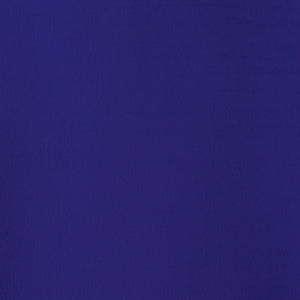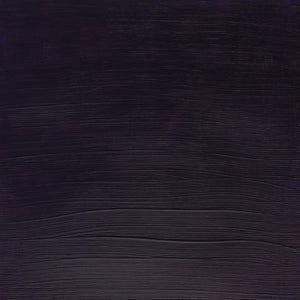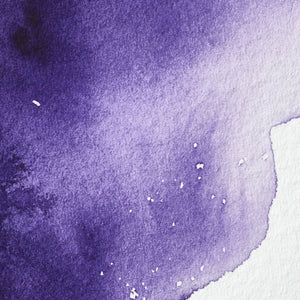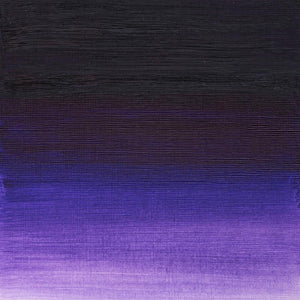
Winsor Violet, also known as Dioxazine, is a vivid purple pigment introduced to the Winsor & Newton range in the 1960s. It is one of the bluest shades of violet, and its strong mass tone is almost black. But when diluted, it reveals a paler soft violet. Where does the versatile violet colour come from, how do we perceive it and how does it interact with others?
In an artist’s colour wheel, violet falls between red and blue. It is placed after indigo on Isaac Newton’s seven-colour rainbow spectrum (red, orange, yellow, green, blue, indigo, violet). Perhaps it is this fact that makes violet so alluring – it sits on the very edge of our vision.
After violet comes ultraviolet (or ‘beyond’ violet from the Latin ‘ultra’), which is invisible to most humans but can be seen by some insects and birds. For example, butterflies use ultraviolet signals as a communication system for nectar guides and mating. Maybe because of our inability to visibly perceive beyond violet, the colour is used to represent the fringe of knowledge, in the spiritual, magical and mysterious.
Where purple pigments often derived from natural sources – such as crushed mollusc shells used to produce the prestigious Tyrian purple – true violet pigments were even rarer. True violet is often created through mixing other colours, such as red and blue. Its scarcity as a natural pigment meant that in the past it was often reserved for royalty and the very wealthy.
The development of new pigments accelerated during the 18th century with advancements in chemistry. By the 19th century, violet was strongly connected to Impressionism. Monet, Pissarro and Manet began to see shades of colour in the shadows rather than black or grey. They abandoned the use of black and instead used tones of violet to depict darkness in their work. This led to the artists being dubbed as having ‘Violettomania’: an obsession with using shades of violet in their paintings. It was Monet who declared: ‘I have finally discovered the true colour of the atmosphere. It is violet. Fresh air is violet.’ We can see Monet’s love for the colour in canvasses such as ‘Springtime’ and ‘Waterlilies’.
The public interest in violet began to grow, in other areas such as fashion and interior design. But it was only as recently as the 20th century that synthetic pigments of violet were invented, which made the colour even more accessible. This included lightfast violet hues such as Winsor Violet, made from PV23 (Pigment Violet 23).






![W&N BLACK FINELINER LS 0.1 [CAP ON]](http://uk.winsornewton.com/cdn/shop/files/64128.jpg?crop=center&v=1736866967&width=20)
![WN COTMAN 8 PC FLORAL POCKET BOX [OPEN WITH STICKER] 884955081129](http://uk.winsornewton.com/cdn/shop/files/132624.jpg?crop=center&v=1761839596&width=20)
![W&N COTMAN WATERCOLOUR 8HP FLORAL POCKET SET [FRONT]](http://uk.winsornewton.com/cdn/shop/files/97499.jpg?crop=center&v=1760698026&width=20)

![WN PROMARKER COOL GREY 3 [COMPOSITE] 884955041406](http://uk.winsornewton.com/cdn/shop/files/77586.jpg?crop=center&v=1741263144&width=20)

![W&N SERIES 7 KOLINSKY SABLE BRUSH ROUND [SHORT HANDLE]](http://uk.winsornewton.com/cdn/shop/files/11424.jpg?crop=center&v=1762864605&width=20)
![W&N GALERIA ACRYLIC TUBE 60ML TITAN WHITE 08 [COMPOSITE] 094376914061](http://uk.winsornewton.com/cdn/shop/files/9396.jpg?crop=center&v=1714072593&width=20)
![W&N GALERIA [SWATCH] TITANIUM WHITE](http://uk.winsornewton.com/cdn/shop/files/3097.jpg?crop=center&v=1714072593&width=20)
![W&N GALERIA CARDBOARD SET 10X12ML 884955097809 [OPEN]](http://uk.winsornewton.com/cdn/shop/files/138856.jpg?crop=center&v=1725031476&width=20)
![W&N GALERIA CARDBOARD SET 10X12ML [B014096] 884955097809 [FOP]](http://uk.winsornewton.com/cdn/shop/files/138855.jpg?crop=center&v=1725031475&width=20)